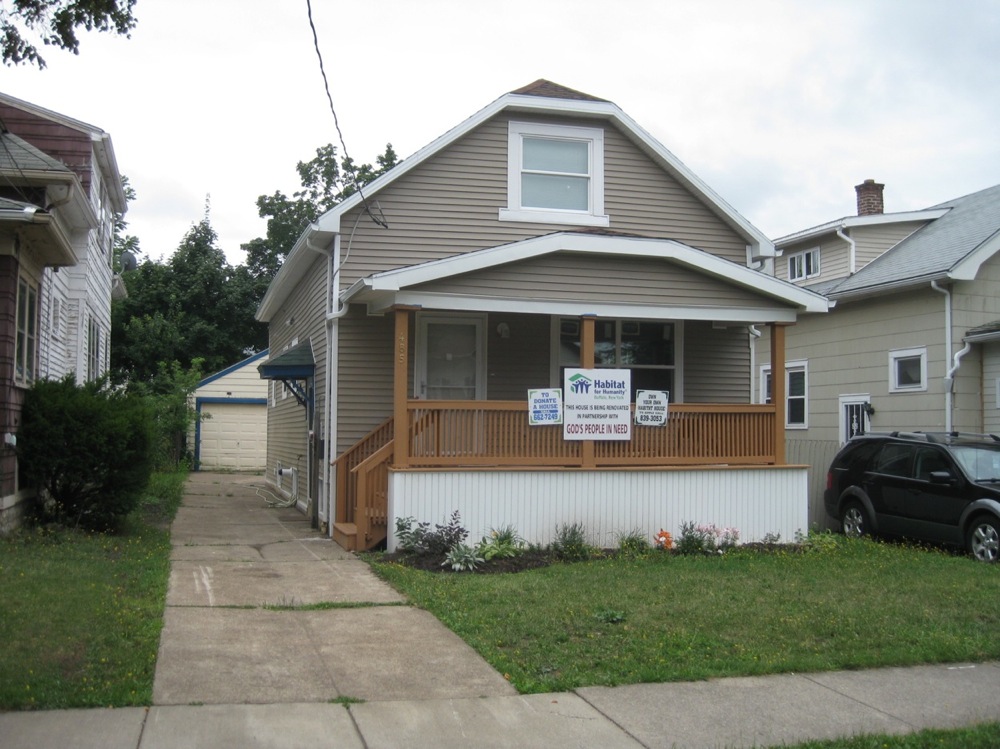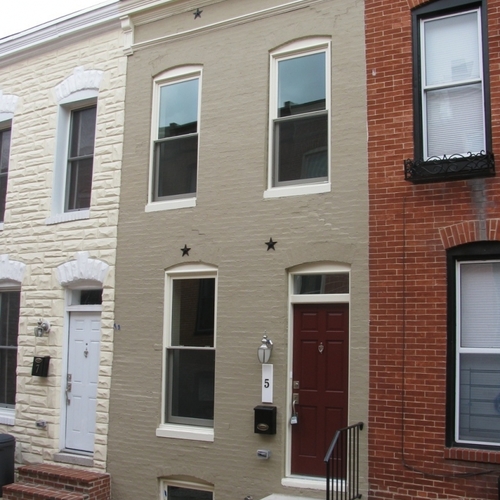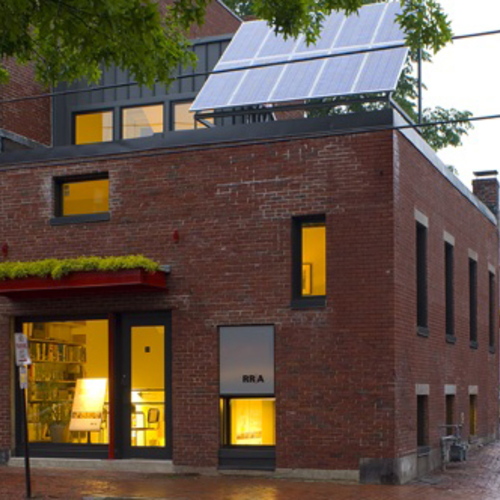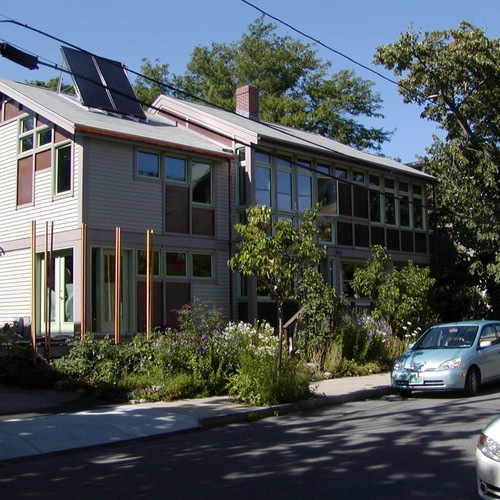
Image Credit: Buffalo HFH
Image Credit: Buffalo HFH All potential rehab homes go through a rigorous initial assessment, with a special focus on basements and moisture.
Image Credit: Buffalo HFH Structural issues with the existing home are addressed first in the Buffalo HFH approach.
Image Credit: Buffalo HFH Rework of the home almost always starts with insulating and air sealing of the rim joist.
Image Credit: Buffalo HFH Volunteer-friendly high performance walls: furring out all exterior walls with 1.5-inch ripped down stud extensions, creating a full 2 by 6 wall cavity.
Image Credit: Buffalo HFH Furring out the exterior envelope is carried out on the 2nd floor, including at the rafter line.
Image Credit: Buffalo HFH Buffalo HFH typically does not work on the exterior wall cladding as part of their approach, but if they do, it is largely a cosmetic and volunteer-friendly vinyl siding that goes up.
Image Credit: Buffalo HFH
Habitat for Humanity Buffalo renovates 10 – 12 homes a year with a largely volunteer workforce using a tried and true approach
Don Marx is a very busy man for a guy who is “retired.” But as Chair of Construction on the Habitat for Humanity Buffalo Board, he manages as many as 12 whole-house renovations and 4 new homes a year. That’s supervising 8,000 volunteer labor hours for each renovation and 4,000 hours for each new home. And all of Don’s hours are in that total; he is a volunteer himself.
Habitat for Humanity Buffalo
Founded in 1985, Habitat for Humanity Buffalo (HFHB) serves the entire city of Buffalo and the neighboring city of Lackawanna. All Habitat organizations follow the same social and financial formula: qualifying families receive a no-interest mortgage; they must make a downpayment on the loan and must complete a minimum of 500 sweat equity hours before owning a home (they work on their own homes usually, but on other Habitat homes as well). Since 1985 HFHB has built or gut-rehabbed more than 200 homes providing quality housing for more than 850 people, including more than 550 children.
HFHB has more than a bit of a specialty in renovating homes within the Habitat system. Usually, homes are either donated to HFHB (the owners can get a tax deduction for the appraised value) or lots are purchased from the City of Buffalo for $1. When I first learned about Habitat’s premier green renovation approach from Kevin Gobble, Director of Sustainable Building and Design for Habitat for Humanity International, Kevin right away said, “Talk to Don Marx at HFHB.”
How HFHB does green renovation
The trouble with Kevin’s recommendation is that Don is a really busy guy, given his role managing all that renovation work. But fortunately, Don is also a really good guy and he took time on more than one occasion to explain the HFHB approach to green renovation.
“First, we don’t take donated homes sight unseen, we do a thorough assessment with a focus on structural integrity and moisture management. We look for leaks,” said Don Marx.
Don continues: “We do every home in much the same way: we work almost exclusively from the inside, taking everything down to bare studs. Every home gets new heating, plumbing, electrical, insulation [and air sealing], wallboard, and a new kitchen and bath set-up. Most of the work is done by volunteers with specialty work like plumbing and electrical being completed or at least led by tradespeople.”
A key to this interior approach is furring out every 2 by 4 stud on exterior walls to the depth of a 2 by 6. “Over time, this has proven to be the most effective and efficient way to meet our home performance goals. It’s labor intensive but inexpensive and relatively easy to do. And remember, we have the labor,” quips Don.
Other elements of HFHB green include tankless water heating, 90 – 92% AFUE furnaces, low-VOC paints and sealants, and airtightness around 2 -3 ACH50, and no central air conditioning. A key element of their green approach is EPA Energy Star and the USGBC LEED for Homes programs.
Energy Star and LEED
HFHB is committed to each and every one of its homes being Energy Star certified. “Typically, our rehab homes score between 57 and 60, and our newhomes about a 50 HERS rating,” says Don. “And our first LEED new home came in at the Gold level and was the first single family LEED home in Western New York.” Don and HFHB think that renovating or building small energy-efficient, comfortable, and quality affordable homes is just about as green as it gets.
“But frankly,” Don adds, the actual building and renovating is a lot easier than the paperwork and process of getting the certifications!”
One more element of green: ReStore
In 2005, HFHB opened its first ReStore, a non-profit used building materials and furnishings retail operation. The first US Habitat ReStore opened in Austin, TX in 1992. Now there are more than 700 ReStores nationwide, raising funds for Habitat construction and renovation operations and diverting tons of useful materials away from our landfills. The operations of HFHB’s first ReStore has been so successful and popular that they just opened up their 2nd one, ReStore South. And while not as many building materials from ReStore operations end up in HFHB construction projects, many furnishings and appliances do.
Proud of their program and their people
This is the Bunton family’s second Christmas in their retrofit HFH home and they love decorating it for the holidays. Ms. Toccaria Bunton says that her house is an investment that she can build financial security with over the coming years. She has repainted her porch floor and likes gardening in the yard where her son can safely play. He has the stability home ownership brings, and she is enjoying the responsibility and the hope her home brings.
“Our Energy Star, green homes save our Habitat homeowners about $17/month on energy costs along with more comfortable living, especially in western New York cold winters,” says Ron Talboys, President, Habitat Buffalo Board of Directors.
Weekly Newsletter
Get building science and energy efficiency advice, plus special offers, in your inbox.
Lessons Learned
Don Marx has been grappling with the best approach for a vapor retarder on their gut rehabs. “There is no shortage of discussion on just what to use and what not to use as a vapor retarder for a climate like Buffalo,” says Marx. At about 6800 heating degree days and with no exterior insulation to “warm” the framing cavities and the first condensing surface, HFH Buffalo definitely needs a vapor retarder on the interior of their walls and attic spaces. The problem with polyethylene sheeting is that its very low vapor permeability (.1 perms or less) permits no drying to the interior as it keeps wintertime interior moisture from getting into building assemblies. The options for Marx to consider that sufficiently retard vapor in the winter while maintaining some drying potential to the interior for the rest of the year are: kraft paper faced batts (variable vapor permeability but about 1 perm), CertainTeed’s Membrain (variable vapor permeability but about 1 perm) or a vapor retarder primer paint (about 1 perm).
For more information
The reHABITAT Guide: For Energy- and Resource-Efficient Retrofit Strategies
Greening the Residential Remodel (on-line webinar by Kevin Brown of HFHI)
General Specs and Team
| Location: | Buffalo, NY |
|---|---|
| Bedrooms: | 3 |
| Bathrooms: | 1.5 |
| Living Space: | 1400 |
| Cost: | 35 |
| Additional Notes: | This cost per square foot includes both volunteer labor and significant donations of materials and equipment. |
HFH National Green Product Partners - Dow insulation - Rinnai tankless water heaters - SquareD home electronics - Valspar Paint - Whirlpool Energy Star appliances - Kohler plumbing fixtures Local Sponsors of HFH Buffalo Green Rehabs - 58 Churches - Regular work crews; fund raising; events - Value Home Centers - TV Channels 4 & 7 - General Mills - Target Stores - Aid Association for Lutherans - United Christian Builders - Westwood Squibb - House Pin Fund - M&T Bank - Clarence Community - A Women’s Place - Quebecor Printing - Advest Corp. - Resurrection Lutheran - Niagara Frontier Builders - Baillie Lumber Co. - Kistner Concrete - J. Crowley Estate - Nationwide Ins. - Buffalo Bills - Choice One Communication - 84 Lumber - Executive Women Intl. - Carpenters Club - House Built w/ Congress - United Way - SEFA - CFC - West Seneca Lions - South Buffalo-Lackawanna Lions - Citigroup Foundation - Key Bank Mortgage - East Hill Foundation - Clarence UM - Lafarge of No. America - Operating Engineers - Local 17 - Thrivent Financial - Reifler Concrete - Hilb Rogal & Hobbs - Odin Berkana Fdn. - National Fuel - Buffalo - Niagara Assoc. of Realtors - Wendt Foundation - Buffalo Area Businesses - HSBC Mortgage Corp.











3 Comments
Interior rigid foam
Would it be more cost effective and energy efficient to just apply 1 or 2" of rigid foam under the drywall? That is what I have done in my house and along with making a conditioned attic with expanding foam I have cut my heating costs to less than half here in Flagstaff, AZ, USDA 5.
Yes, I understand that the material is more expensive per square foot and they have free labor, but?
Response to Ed Dunn
Ed,
One thing I've learned over the years is that if you talk to 6 builders about an easy-to-build insulated wall, each builder will describe a different approach -- and each builder will swear that their way is the easiest and cheapest way to do it.
Actually, everybody's right -- because if a builder is familiar with an approach that works for him or her, that's probably the best approach to use.
For more information on interior foam, see Walls With Interior Rigid Foam.
Interior rigid foam
Interesting comments.
In my experience working with HFH, two things drive the approach: donated materials and REALLY easy DIY installation. In this case, with DOW being a donor, you make a good case for the advantage of interior rigid foam. But maybe unleashing HFH volunteers with really long drywall nails or screws to go through the rigid interior foam was the drawback!
From a building science point of view, the interior rigid foam means the primary drying potential with interior rigid foam would be to the exterior--and that works fine for this project. And in retrofit, designated drying to the exterior means that occupants can add pretty much whatever they want to the interior of exterior walls over the years.
Log in or create an account to post a comment.
Sign up Log in